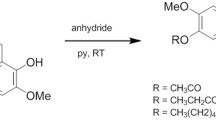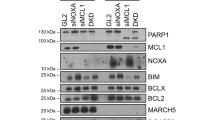Abstract
Naphthazarin (DHNQ, 5,8-dihydroxy-l,4-naphthoquinone) is a naturally available 1,4-naphthoquinone derivatives. In this study, we focused on elucidating the cytotoxic mechanism of naphthazarin in A549 non-small cell lung carcinoma cells. Naphthazarin reduced the A549 cell viability considerably with an IC50 of 16.4 ± 1.6 μM. Naphthazarin induced cell death in a dose- and time-dependent manner by activating apoptosis and autophagy pathways. Specifically, we found naphthazarin inhibited the PI3K/Akt cell survival signalling pathway, measured by p53 and caspase-3 activation, and PARP cleavage. It also resulted in an increase in the ratio of Bax/Bcl2 protein levels, indicating activation of the mitochondrial apoptotic pathway. Similarly naphthazarin triggered LC3II expression and induced autophagic flux in A549 cells. We demonstrated further that naphthazarin is a microtubule inhibitor in cell-free system and in A549 cells. Naphthazarin treatment depolymerized interphase microtubules and disorganised spindle microtubules and the majority of cells arrested at the G2/M transition. Together, these data suggest that naphthazarin, a microtubule depolymerizer which activates dual cell death machineries, could be a potential novel chemotherapeutic agent.












Similar content being viewed by others
References
Papageorgiou VP, Assimopoulou AN, Couladouros EA, Hepworth D, Nicolaou KC (1998) The chemistry and biology of alkannin, shikonin and related naphthazarin natural products. Angew Chem Int Ed 38:270–300
Assimopoulou AN, Boskou D, Papageorgiou VP (2004) Antioxidant activities of alkannin, shikonin and Alkanna tinctoria root extracts in oil substrates. Food Chem 87:433–438
Chien Chang S, Wan S Jr, Shyh-Yuan L, Chia-Hung L, Gum-Hee L, Chang Ming S (2002) Antimicrobial activities of naphtazarins from Arnebia euchroma. J Nat Prod 65:1857–1862
Sasaki K, Abe H, Yoshizaki F (2002) In vitro antifungal activity of naphthoquinone derivatives. Biol Pharm Bull 25:669–670
Assimopoulou AN, Papageorgiou VP (2005) Radical scavenging activity of Alkanna tinctoria root extracts and their main constituents hydroxyl naphthoquinones. Phytother Res 19:141–147
Ozaki Y, Sakaguchi I, Tujimura M, Ikeda N, Nakayama M, Kato Y, Suzuki H, Satake M (1998) Study of the accelerating effect of granulation tissue in rats. Biol Pharm Bull 21:366–370
Sanakawa U, Ebizuka Y, Miyazaki T, Isomura Y, Otsuka H, Shibata S, Inomata M, Fukuoka F (1977) Anti-tumor activity of shikonin and its derivatives. Chem Pharm Bull 25:2392–2395
Delgado MA, Elmaoued RA, Davis AS, George K, Deretic V (2008) Toll-like receptors control autophagy. EMBO J 27:1110–1121
Xu Y, Jagannath C, Liu XD, Sharafkhaneh A, Kolodziejska KE, Eissa NT (2007) Toll-like receptor 4 is a sensor for autophagy associated with innate immunity. Immunity 27:135–144
Eisenberg-Lerner A, Bialik S, Simon HU, Kimchi A (2009) Life and death partners: apoptosis, autophagy and the cross-talk between them. Cell Death Differ 16:966–975
Levine B, Yuan J (2005) Autophagy and cell death: an innocent convict? J Clin Invest 115:2679–2688
Maiuri MC, Zalckvar E, Kimchi A, Kroemer G (2007) Self-eating and self-killing: crosstalk between autophagy and apoptosis. Nat Rev Mol Cell Biol 8:741–752
Hickman JA (1992) Apoptosis induced by anticancer drugs. Cancer Metastasis Rev 11:121–139
Kondo Y, Kanzawa T, Sawaya R, Kondo S (2005) The role of autophagy in cancer development and response to therapy. Nat Rev Cancer 5:726–734
Paz-Ares L, Blanco-Aparicio C, García-Carbonero R, Carnero A (2009) Inhibiting PI3K as a therapeutic strategy against cancer. Clin Transl Oncol 11:572–579
Earnshaw WC, Martins LM, Kaufmann SH (1999) Mammalian caspases: structure, activation, substrates and functions during apoptosis. Annu Rev Biochem 68:383–424
Vivanco I, Sawyers CL (2002) The phosphatidylinositol 3-kinase-Akt pathway in human cancer. Nat Rev Cancer 2:489–501
Lodish H, Baltimore D, Berk A, Zipursky SL, Matsudaira P, Darnell J (1999) Molecular cell biology, 5th edn. W. H. Freeman, New York, pp 806–827
Jordan MA, Wilson L (2004) Microtubules as a target for anticancer drugs. Nat Rev Cancer 4:253–265
Jordan MA (2002) Mechanism of action of antitumor drugs that interacts with microtubules and tubulin. Curr Med Chem Anticancer Agents 2:1–17
Acharya BR, Bhattacharyya B, Chakrabarti G (2008) The natural naphthoquinone plumbagin exhibits antiproliferative activity and disrupts the microtubule network through tubulin binding. Biochemistry 47:7838–7845
Acharya BR, Choudhury D, Das A, Chakrabarti G (2009) Vitamin K3 disrupts the microtubule networks by binding to tubulin: a novel mechanism of its antiproliferative activity. Biochemistry 48:6963–6974
Bonfoco E, Ceccatelli S, Manzo L, Nicotera P (1995) Colchicine induces apoptosis in cerebellar granule cells. Exp Cell Res 218:189–200
Liu XM, Wang LG, Kreis W, Budman DR, Adams LM (2001) Differential effect of vinorelbine versus paclitaxel on ERK2 kinase activity during apoptosis in MCF-7 cells. Br J Cancer 85:1403–1411
Levine B, Klionsky DJ (2004) Development by self-digestion. Dev Cell 6(4):463–477
Alva AS, Gultekin SH, Baehrecke EH (2004) Autophagy in human tumors: cell survival or death? Cell Death Differ 11:1046–1048
Gozuacik D, Kimchi A (2004) Autophagy as a cell death and tumor suppressor mechanism. Oncogene 23:2891–2906
Kochl R, Tooze SA (2006) Microtubules facilitate autophagosome formation and fusion of autophagosomes with endosomes. Traffic 7:129–145
Reunanen H, Marttinen M, Hirsimaki P (1988) Effects of griseofulvin and nocodazole on the accumulation of autophagic vacuoles in Ehrlich ascites tumor cells. Exp Mol Pathol 48:97–102
Fengsrud M, Roos N, Berg T, Liou W, Slot JW, Seglen PO (1995) Ultrastructural and immunocytochemical characterization of autophagic vacuoles in isolated hepatocytes: effects of Vinblastine and Asparagine on vacuole distributions. Exp Cell Res 221:504–519
Po-Lin K, Ya-Ling H, Chien-Yu C (2006) Plumbagin induces G2-M arrest and autophagy by inhibiting the AKT/mammalian target of rapamycin pathway in breast cancer cells. Mol Cancer Ther 5(12):3209–3221
Amaravadi RK, Yu D, Lum JJ, Bui T, Christophorou MA, Evan GI, Thomas-Tikhonenko A, Thompson CB (2007) Autophagy inhibition enhances therapy-induced apoptosis in a Myc-induced model of lymphoma. J Clin Invest 117:326–336
Boya P, Gonzalez-Polo RA, Casares N, Perfettini JL, Dessen P, Larochette N, Metivier D, Meley D, Souquere S, Yoshimori T, Pierron G, Codogno P, Kroemer G (2005) Inhibition of macroautophagy triggers apoptosis. Mol Cell Biol 25:1025–1040
Ci-Hui Y, Zhong-Qin L, Zhen-Lun G, Ya-** Y, Paul R, Zheng-Hong Q (2006) Contributions of autophagic and apoptotic mechanisms to CrTX-induced death of K562 cells. Toxicon 47:521–530
Cheng Y, Feng Q, Takashi I (2009) Molecular mechanisms of oridonin-induced apoptosis and autophagy in murine fibrosarcoma L929 cells. Autophagy 5(3):430–431
Bradford MM (1976) A rapid and sensitive method for the quantitation of microgram quantities of protein utilizing the principle of protein-dye binding. Anal Biochem 72:248–254
Sen T, Moulik S, Dutta A, Choudhury PR, Banerji A, Das S, Roy M, Chatterjee A (2009) Multifunctional effect of epigallocatechin-3-gallate (EGCG) in down regulation of gelatinase-A (MMP-2) in human breast cancer cell line MCF-7. Life Sci 84:194–204
Minnoti AM, Barlow SB, Cabral F (1991) Resistance to antimitotic drugs in Chinese hamster ovary cells correlates with changes in the level of polymerized tubulin. J Biol Chem 266:3987–3994
Hamel E, Lin CM (1981) Glutamate-induced polymerization of tubulin: characteristics of the reaction and application to the large scale purification of tubulin. Arch Biochem Biophys 209:29–40
Gaskin F, Cantor CR, Shelanski ML (1974) Turbidimetric studies of the in vitro assembly and disassembly of porcine neurotubules. J Mol Biol 89:737–755
Kanzawa T, Kondo Y, Hideki I, Germano I (2003) Induction of autophagic cell death in malignant glioma cells by arsenic trioxide. Cancer Res 63:2103–2108
Liu B, Cheng Y, Zhang B, He-jiao B, **-Ku B (2009) Polygonatum cyrtonema lectin induces apoptosis and autophagy in human melanoma A375 cells through a mitochondria-mediated ROS–p38–p53 pathway. Cancer Lett 275:54–60
Munafo DB, Colombo MI (2001) A novel assay to study autophagy: regulation of autophagosome vacuole size by amino acid deprivation. J Cell Sci 114:3619–3629
Mizushima N, Yoshimori T (2007) How to interpret LC3 immuno-blotting. Autophagy 3(6):542–545
Jeong-Sun J, Varadhachary AS, Miller SE, Weihl CC (2010) Quantitation of “autophagic flux” in mature skeletal muscle. Autophagy 6(7):929–935
**ao H, Jian-xun L, **n-zhi L (2011) Salvianolic acid B inhibits autophagy and protects starving cardiac myocytes. Acta Pharmacol Sin 32:38–44
Huang SW, Liu KT, Chang CC, Chen YJ, Wu CY, Tsai JJ, Lu WC, Wang YT, Liu CM, Shieh JJ (2010) Imiquimod simultaneously induces autophagy and apoptosis in human basal cell carcinoma cells. Br J Dermatol 163(2):310–320
Fujiwara Y, Hosokawa Y, Watanabe K, Tanimura S, Ozaki K, Kohno M (2007) Blockade of the phosphatidylinositol-3-kinase-Akt signaling pathway enhances the induction of apoptosis by microtubule-destabilizing agents in tumor cells in which the pathway is constitutively activated. Mol Cancer Ther 6:1133–1142
Kapeller R, Toker A, Cantley LC, Carpenter CL (1995) Phospho- inositide 3-kinase binds constitutively to alpha/beta-tubulin and binds to gamma-tubulin in response to insulin. J Biol Chem 270:25985–25991
Petiot A, Ogier-Denis E, Blommaart EF, Meijer AJ, Codogno P (2000) Distinct classes of phosphatidylinositol 3-kinases are involved in signaling pathways that control macroautophagy in HT-29 cells. J Biol Chem 275:992–998
Acknowledgments
Authors like to thank Prof. Geri Kreitzer (Department of Cell and Developmental Biology, Weill Cornell Medical College, Cornell University, USA) for her critical reading of the manuscript. The work was supported by grants from DST, Govt. of India (No. SR/SO/BB-14/2008) and DBT, Govt. of India (No. BT/PR12889/AGR/36/624/2009) to GC. Confocal Microscope and FACS facilities are developed by the grant from National Common Minimum Program, Govt. of India.
Conflict of interest
The authors declare that there are no conflicts of interest.
Author information
Authors and Affiliations
Corresponding author
Rights and permissions
About this article
Cite this article
Acharya, B.R., Bhattacharyya, S., Choudhury, D. et al. The microtubule depolymerizing agent naphthazarin induces both apoptosis and autophagy in A549 lung cancer cells. Apoptosis 16, 924–939 (2011). https://doi.org/10.1007/s10495-011-0613-1
Published:
Issue Date:
DOI: https://doi.org/10.1007/s10495-011-0613-1




